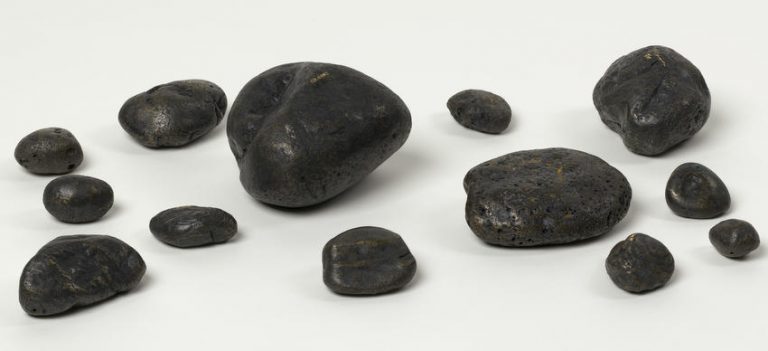We acknowledge the Traditional Owners of the land on which the Queensland Art Gallery | Gallery of Modern Art stands and recognise the creative contribution First Australians make to the art and culture of this country.

Philip Corner / United States b.1933 / Sound stones 1985 / Bronze with ball bearings enclosed, ed. 1/21 / 13 stones / Gift of Francesco Conz through the Queensland Art Gallery Foundation 1995 / Collection: Queensland Art Gallery | Gallery of Modern Art / © Philip Corner
Philip CornerSound stones 1985
Not Currently on Display
Sound stones, by Fluxus artist Philip Corner, explores the paradoxical notion of ‘stones that rattle’. These bronze castings of river stones from Verona, in Italy, contain small metal ball bearings. When the stones are shaken, the sounds vary subtly and, depending on the situation and who is playing them, result in different ‘compositions’ each time they are moved.
Fluxus was a term coined in 1962 to describe the activities, festivals, performances and artworks produced by artists from several countries whose aim was to make art interact with life, as well as to eradicate boundaries between art forms and disciplines. As the word ‘Fluxus’ suggests, the flow of one moment into the next is a guiding principle in performance-based events. It is not as important to reach the end of a particular action as it is to experience the process. Music provides a context for many Fluxus objects, even if they are not instruments in a conventional sense, and events.
Philip Corner was born in 1933 in New York. He studied music at City College of New York, gaining a Bachelor of Arts in 1955 and undertook further studies at the Paris Conservatoire (in 1956–57) and at Columbia University, New York, where he gained a Master of Arts.
Corner became interested in Eastern music during military duty in Korea in 1959–60, after which he began to assimilate the teachings of John Cage into chance and systematic procedures for music performances.
Corner is noted for his compositional technique integrating methodical and improvisational procedures as applied to a variety of instruments and objects. His works for Editions Conz include calligraphic silkscreened Fluxus scores, printed textiles, and works such as Sound stones.
Discussion Questions
Why do you think the work is titled Sound stones? Describe what sounds you think the stones make.
Classroom Activities
1. Sit very still. Close your eyes and listen to the sounds around you. Open your eyes and list as many as you can from memory.
2. Create your own musical instrument. Consider how it could be experienced as a static object as well as activated by the audience.